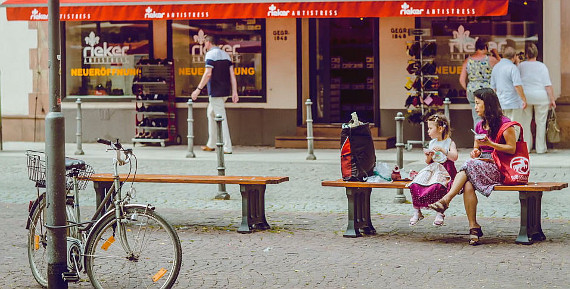Phillip Bloom has been making films for 25 years, and wherever he goes for his work, he likes to take along his still cameras and walk about the city capturing photos on the street. Bloom has recently converted to film for his personal use and says he generally takes 4-6 cameras with him when he goes out. Though he admits it is a bit of an overhaul, he loves the challenge and satisfaction of shooting film:
“No matter where I go, my camera goes with me, cause there’s always a story around the corner.”
Challenges of Using Old Film Cameras:
- No Autofocus – That’s right. No pressing a button to have your camera automatically focus on the subject for you. You have to manually turn the lens to get your subject properly in focus.
- No Auto Metering – Some older cameras have light meters, and some do not. Regardless, they are not automatic. You will need to change the shutter speed and aperture for every shot.
- One ISO Speed – With film you lose the convenience of changing your ISO setting at will. Once you stick a roll of film in your camera, you’re dedicate to one film speed until you switch rolls.
- No Image Review – Of course one of the biggest differences is that you can’t see your image immediately afterwards. This is why you take more time to select and frame a scene. You can’t just delete your photo and take another, and each frame is costing you money.
- Framing Issues – If you’re using a film SLR, then this won’t be any different from a DSLR. But using a TLR or rangefinder camera can provide issues with accurately framing your scene, especially at close distances.

Philip Bloom says he prefers the way film makes you stop and think about the image you’re capturing
“Using these old cameras is a challenge as well. It’s not as easy as just getting out an iPhone or getting out a digital compact with autofocus and auto everything. You actually have to make sure your settings are correct, so not only do you need to capture the moment, you need to get the settings of the camera right at the same time. So, you have a double challenge.”
Like This Article?
Don't Miss The Next One!
Join over 100,000 photographers of all experience levels who receive our free photography tips and articles to stay current:






There are a lot of things that work better or are more satisfying with film. But AF and autometering aren’t really a film/digital argument. My first serious camera was Nikon FG, and though I did have an external meter, I rarely used it because the internal meter usually served my needs. And though I mostly shoot a Nikon D60 now, I STILL manually focus–I haven’t been able to afford to get new lenses, so I’m still using the ones I bought for the FG. In fact, only one of them will even autometer–the rest I have no choice but to put the camera in manual and employ the “Mk 1 eyeball” (and heavy use of image reviewing). Which is about 80% of the time.
Using a 28mm or 24mm lens at f/8 when zone focusing works well enough in keeping scenes in focus as the DOF is still quite deep, especially at around 10 feet. Even 5.6 at close proximity is very reliable. Helps to maintain higher shutter speeds without resorting to pushing the film. I’ll even shoot from the hip and still keep my subject in focus. The longer throw of many older manual lenses is also beneficial in maintaining accuracy. But I’ll use f/11 if the sun is way too bright and have maxed out my shutter.
With street photography you have to be alert and quick. The less gadgets to slow you down, the better.
There are film cameras that do have autofocus but if you are shooting with a rangefinder you can actually focus faster and with more accuracy than autofocus. You can also stand develop your film and get a usable image with multiple ISOs per roll. I hate saying nice things about Kodak Alaris but you can use their Portra 400 at a huge range of film speeds without need to compensate.
Not really much of a challenge for a photographer to make images with a film camera. I shoot almost daily with film cameras – you don’t need to change shutter or fstop EVERY FRAME as it says above… if the light stays the same. You don’t need AF with ZONE FOCUSING. For those of you who aren’t familiar with zone focusing you essentially use a high f-stop number with a deep depth of field (f/16 or f/11) and have your camera pre-focused to a certain distance to get your photos in-focus. This is beneficial because although modern autofocusing systems are quite good, they are not 100% reliable. Using zone focusing when shooting street photography allows you to get far more keepers.